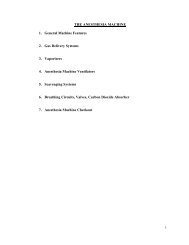BUMC Basics.pdf - Anesthesia Home
BUMC Basics.pdf - Anesthesia Home
BUMC Basics.pdf - Anesthesia Home
You also want an ePaper? Increase the reach of your titles
YUMPU automatically turns print PDFs into web optimized ePapers that Google loves.
91<br />
• After 1 wk of intubation determine likelihood of<br />
extubation at 2wks. If unlikely proceed with<br />
bedside/surgical tracheostomy with a GS<br />
• Tracheostomy may be beneficial because it is more<br />
comfortable, more ease in clearing secretions, decreased<br />
airway resistance, decreased laryngeal injury, can eat<br />
orally, can partially vocalize, etc.<br />
- Complications: Infection (mediastinitis), bleeding,<br />
accidental removal with closure of stoma and then<br />
blind reinsertion potentially creating a false tract,<br />
injury to surrounding structures<br />
- Consider a Passy-Muir valve when a patient has a<br />
trach after weaning off ventilator to help with talking.<br />
The Passy-Muir valve acts as a one-way valve<br />
allowing air to go in through the trach and be exhaled<br />
through the native airway.<br />
- You can put a red cap over trach and see if pt can<br />
breath/talk fine, and, if so, you can decanulate the<br />
patient (the hole closes on its own in 2-3d)<br />
Oxygen Toxicity — Remember oxygen toxicity (FiO2 >60%<br />
for >48hrs) from the production of oxidizing radicals which<br />
damage membranes, denature proteins, and break DNA<br />
Cardiac Output Changes — Can reduce cardiac output<br />
because of decreased venous return and increase right<br />
ventricle afterload<br />
Respiratory Muscle Atrophy<br />
Trauma to Airway, Dentition, etc<br />
ETT Migration (normally the tip of the ETT should be 2cm<br />
above carina)<br />
Critical Illness Polyneuropathy/Myopaythy<br />
• Consider when patients continually need MV despite<br />
resolution of primary problem<br />
After Extubation<br />
• Sore throat, Hoarseness, Cough, etc: Can be normal<br />
and should resolve.<br />
• Laryngeal Edema<br />
- Usually occurs when patient is extubated from 2-<br />
7days post-extubation. After extubation, an average<br />
of 40% of patients have laryngeal edema but only 5%<br />
having severe obstruction




